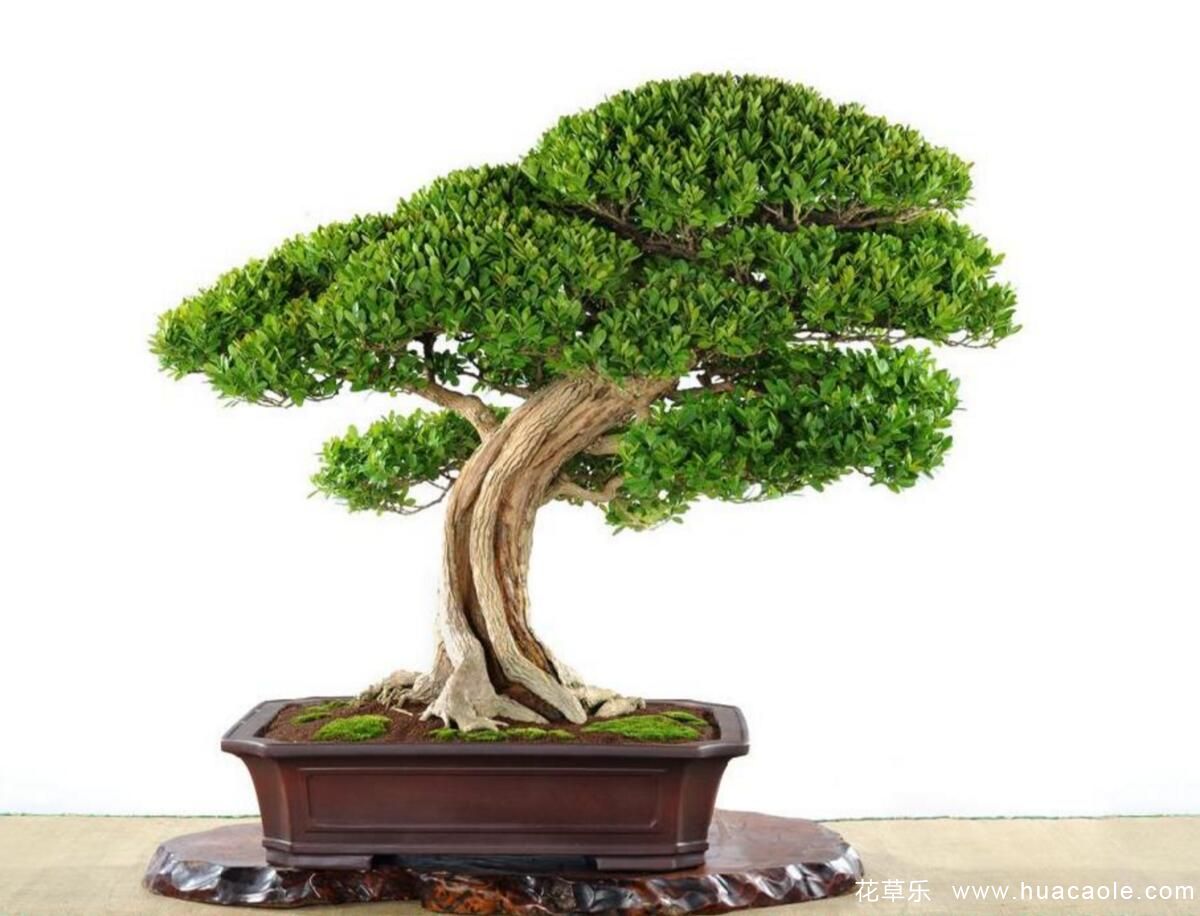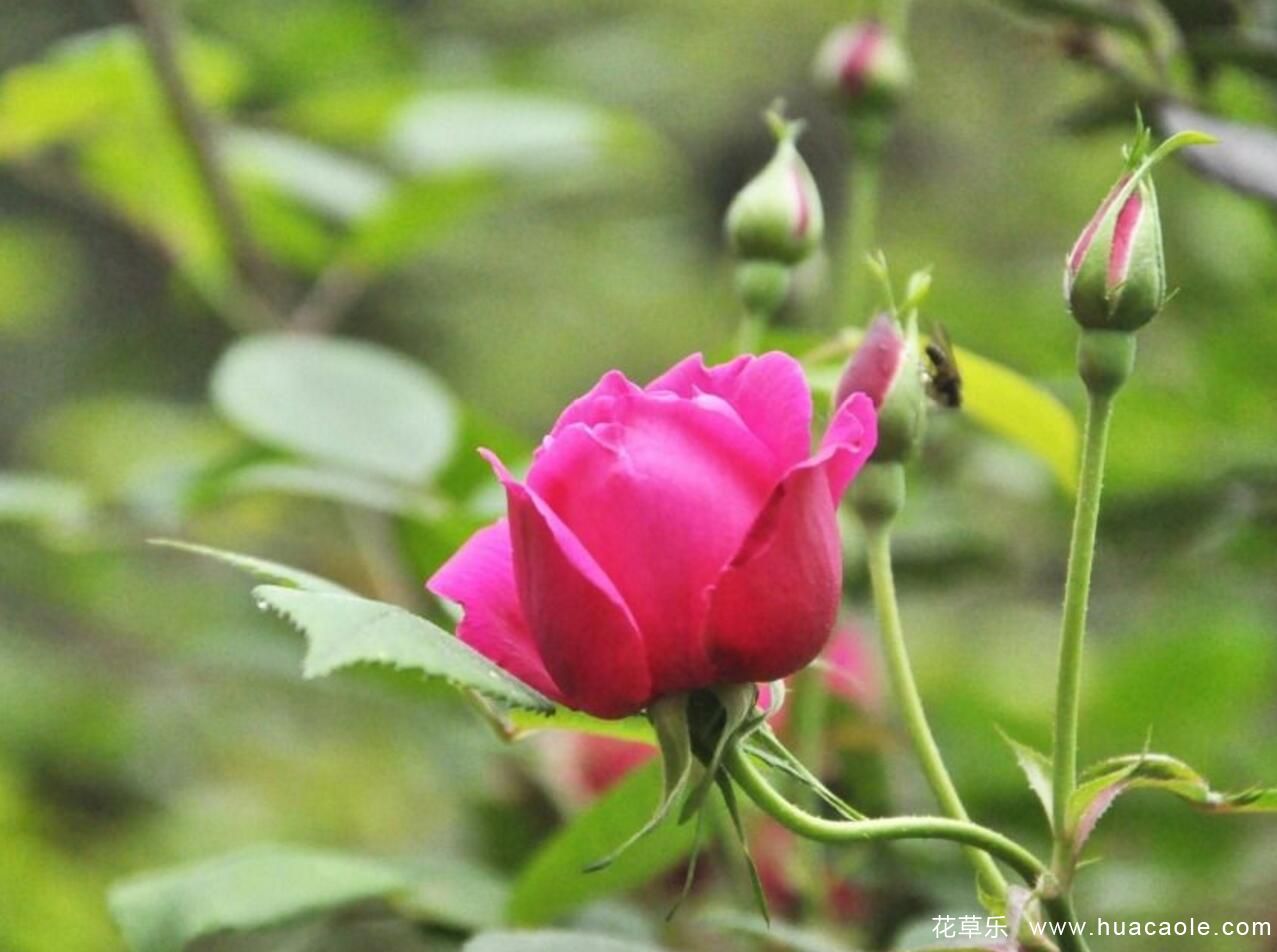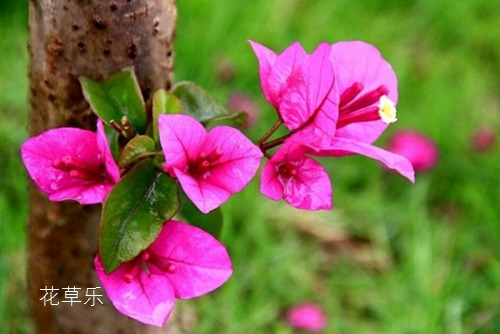Brief introduction of Populus tomentosa, one of the top ten famous trees in China, how to raise it
Poplar bonsai trees are graceful, with leaves as small as beans, thick and shiny, evergreen all the year round, and can be watched all the year round. Yang Pai boxwood bonsai, branches and leaves after cutting processing, into a "cloud sheet", as thin as cut, and then embellished with rocks, elegant and picturesque. The young leaves of Populus tomentosa are young in spring, and the trees are green and pleasing to the eye. The ancients chanted Huang Yang's poems, the poplar tree, the woman to branch thousands of heavy, Ye Shenpu jade, according to the ancient Qiu long. It depicts the grace of boxwood, which is an excellent material for family to cultivate bonsai. Huacao Le shares with you the knowledge of morphological characteristics, breeding and conservation, pest control, value, legends of yellow poplar, etc.

I. morphological characteristics of Populus tomentosa.
Populus tomentosa: shrubs or small trees, 1-6 m tall; branches Terete, longitudinally angled, gray-white; branchlets 4-angled, completely pubescent or outer opposite sides glabrous. Leaves leathery, broadly oval, broadly Obovate, ovate-elliptic or oblong, bright leaves, protruding midvein, often with fine hairs in the lower half. Inflorescences axillary, capitate, densely flowered, male flowers ca. 10, sessile, outer sepals ovate-elliptic, inner sepals suborbicular, 2.5-3 mm long, glabrous, stamens with anthers 4 mm, sterile pistil clavate stalked, terminal inflated; female sepals 3 mm long, ovary slightly longer than style, glabrous. Capsule subglobose. Flowering in March and fruiting in May-June. Multiple valleys, streams, under forests, 1200-2600 m above sea level. It is produced in many provinces and regions of China, some of which belong to cultivation. The varieties of yellow poplar are blueberry leaf yellow poplar, lobular leaf yellow poplar, big leaf yellow poplar and pointed leaf yellow poplar.
2. Growth habits of boxwood
Yellow poplar likes fat loose loam, slightly acidic soil or slightly alkaline soil can adapt, and can also grow in calcareous soil. Pot culture can use mature pastoral soil or rotten leaf soil mixed with appropriate amount of rice chaff ash. It is resistant to overcast and light, and can maintain good growth under general indoor and outdoor conditions. In the long-term shady environment, although the leaves can remain green, it is easy to lead to excessive growth or weakening of branches. Like moist, can withstand the cloudy and rainy weather for about a month, but avoid stagnant water for a long time. Drought tolerance, as long as the surface soil or basin soil is not completely dry, there is no abnormal performance. Heat-resistant and cold-resistant, it can withstand summer exposure and the severe cold of minus 20 degrees Celsius, but it should be ventilated and transparent when it is hot and humid in summer. Loose requirements for soil, easy and fertile sandy loam is better, potted can also be used with vermiculite, peat or soil, strong alkali resistance. Strong tillering, resistant to pruning, easy to shape. After sufficient light and dormancy in autumn, the leaves can turn red.
3. Introduction of culture methods of boxwood.
1. Yellow poplar watering
Yellow poplar trees prefer water, so they should grasp the principle of "better wet than dry" in watering. Irrigation time: each watering time, preferably in the morning and evening, not in the highest temperature at noon.
2. Topdressing of yellow poplar
It can timely supplement the large amount of nutrients needed by seedlings in the period of vigorous growth and development, promote the growth and development of seedlings and improve their quality. no, no, no. The application of nitrogen fertilizer should be carried out in spring and summer, and the last application of nitrogen fertilizer should not be later than the Beginning of Autumn. In order to prevent the seedlings from overgrowing and reduce the overwintering ability of boxwood seedlings. From August to September, the application of nitrogen fertilizer must be stopped, and the main fertilizer should be phosphorus and potassium fertilizer. Promote the Lignification and root growth of Populus tomentosa seedlings, and improve the cold resistance of seedlings.
3. Plastic surgery of boxwood
Cut off overgrown branches, overlapping branches and extra branches that affect the shape of the tree at any time during the growing period. Populus tomentosa germinates faster, generally after sending new shoots, the first 1-2 segments will be cut off to prevent overgrowth. After fruiting, boxwood should be picked in time so as not to consume nutrients and affect the growth of trees.
4. Populus tomentosa turned over
It is usually carried out once every 2-3 years, and it is better to do it before germination in spring. Combined with turning the basin to cut off part of the old roots and over-long and dense roots, replace the old soil and plug it with fertile and loose culture soil to facilitate the root system development.
5. Pest control
The main pests of yellow poplar are shell insects and yellow poplar rulers, which can be killed with manual brushing or 1500 times of dichlorvos, or 1000-2000 times with 40% omethoate. The main disease is coal fouling disease, which will cause defoliation. The key to prevention and treatment is to remove shell insects, and often spray foliar water to wash dust to make it grow well.
Fourth, making boxwood bonsai
1. Bonsai of boxwood is selected.
Seedlings propagated by sowing or cutting can be transplanted to pot for several years. You can also select the old pile from the mountain, dig it up, trim the long roots and dense branches, raise the billet in the open field for 1-2 years, and then go to the basin for processing. When selecting plants, we should pay attention to protecting the surrounding soil and make the tuo as large as possible to maintain sufficient room for root trimming. the root block should be one to two centimeters smaller than the inner diameter of the planting basin.
1 >, select the basin
Boxwood perennial oil green, it is appropriate to use purple sand pottery basin, basin color to purple or light yellow is better. The shape of the basin depends on the form of the shape. The cliff type should use a deep thousand-cylinder basin, while the oblique type or curved dry type should use an oval or rectangular basin.
2 > use soil
Bonsai soil is cultivated with mature pastoral soil or rotten leaf soil mixed with appropriate ridge bran ash, which is suitable for fertile and loose soil, and the loam with good ventilation and permeability is the best. It is advisable to carry lodging soil on the old pile.
3 >, planting
Yellow poplar is more hardy and can be carried out before sprouting in spring. when planting, the root system should be trimmed too long and too dense, and do not make the root nest bend in the basin. Newly planted boxwood should be placed in a semi-shady place.
2. Huang Yang modelling
Populus tomentosa has strong germination. Before modeling, the trunk can be cut off to sprout new technology around or below the cross section, and then climb the branches according to the requirements of artistic modeling, and it is better to use brown silk in spring. It can also be roughly tied and cut to make a cloud sheet or steamed bread, or processed into a natural tree shape. The trunk is made into oblique dry type or prone type according to the natural trend. If the poplar pile scene is embellished with a beautiful stone, it will become a "boxwood bow". Populus tomentosa is very resistant to pruning and strong germination. in order to maintain a beautiful tree shape, it must be processed and reshaped frequently.
5. Prevention and control of diseases and insect pests of boxwood
1. Powdery mildew
Powdery mildew of Euonymus tomentosa is also called powdery mildew. It is often infected with the leaves, neck and other parts of Euonymus tomentosa. When the disease occurs, a layer of white powder appears on the surface of the disease, and when the disease is serious, the leaves of Euonymus tomentosa wilt. The disease often occurs in a hot, humid and unventilated environment.
Control method: spray stone sulfur mixture or topiramate with a density of 1.0035 (0.5 Baume). Carbendazim and other agents.
2. White silk disease of yellow poplar
When the white silk disease of Populus tomentosa occurred, the base turned brown and rotted near the soil, and the mycelium was white silk-like, and then turned yellow to brown such as rapeseed. The disease mostly occurred in the soil moist, rainy, high temperature and high summer season.
Prevention and control methods: the basin soil should be disinfected before use, colleagues should pay attention to environmental ventilation, avoid planting too dense, trim diseased branches. 50% carbendazim wettable powder 500 times should be sprayed regularly before onset.
3. Populus tomentosa leaf spot
The leaf spot of Populus tomentosa is also called black spot. The symptom is the appearance of black spots in the middle of the leaves. Then the leaves fall off yellow. The disease is often caused by poor ventilation and dampness in the environment.
Prevention and treatment methods: pay attention to improving environmental conditions, diseased leaves can be removed at the initial stage of the disease, and concentrated burning, spraying 1% Bordeaux solution 4-5 words, every 7 days.
VI. The main value of boxwood
Poplar bonsai trees are graceful, with leaves as small as beans, thick and shiny, evergreen all the year round, and can be watched all the year round. The wood is hard and fine and is a good material for carving. Roots and leaves can be used as medicine. The function is mainly for expelling wind and dehumidification, promoting qi and promoting blood circulation.
7. Botanical culture of boxwood
Boxwood grows slowly, the wood of boxwood is extremely delicate, brown eyes (pores) are not visible to the naked eye, but it is still because of the slow growth of boxwood, it is difficult to have large materials, and it is often used to match with high-grade mahogany or processed into extremely fine carvings. There are no large works, and because of this, boxwood carvings are often mistaken for ivory production by beginners. It can be said that it is extremely difficult for boxwood to make large pieces of furniture, and if it appears, it will be a treasure.
The aroma of boxwood is very light, very light, elegant and gorgeous, it is the kind of taste that can be described by fragrance, and can drive mosquitoes. In addition, boxwood also has the effect of sterilization and anti-inflammation and hemostasis. Mountain people in the growing area of boxwood have the habit of picking poplar leaves as a hemostatic and placing branches of boxwood to ward off mosquitoes and flies.
Time: 2019-04-29 Click:
- Prev

How to raise cut rose in winter in order to produce a high yield
Winter is the season with a large gap in cut rose, especially in the north. If there are fewer rose flowers, the price of cut flowers will also increase. So how can the winter cut rose be fruitful? Winter rose culture methods have what skills, the following flowers and plants to share with you: first, do a good job of heat preservation measures
- Next

The culture method of triangular plum is so colorful that it blossoms for more than half a year.
Triangular plum, evergreen shrub, bright red flowers, larger flowers, every 3 bracts together a small triangular flower, so also known as triangular flower. Triangular plum has a variety of varieties, strong plant adaptability, bright flowers and long flowering period, which is very suitable for potted ornamental plants. How to raise triangulated plum
Related
- Fuxing push coffee new agricultural production and marketing class: lack of small-scale processing plants
- Jujube rice field leisure farm deep ploughing Yilan for five years to create a space for organic food and play
- Nongyu Farm-A trial of organic papaya for brave women with advanced technology
- Four points for attention in the prevention and control of diseases and insect pests of edible fungi
- How to add nutrient solution to Edible Fungi
- Is there any good way to control edible fungus mites?
- Open Inoculation Technology of Edible Fungi
- Is there any clever way to use fertilizer for edible fungus in winter?
- What agents are used to kill the pathogens of edible fungi in the mushroom shed?
- Rapid drying of Edible Fungi

